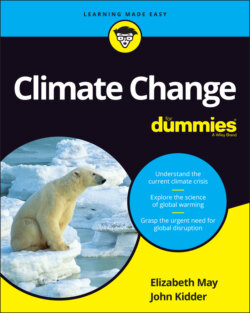Читать книгу Climate Change For Dummies - Elizabeth May - Страница 43
A RECIPE THAT GIVES YOU GAS
ОглавлениеCarbon dioxide is composed of one carbon atom and two oxygen atoms. Present in the atmosphere as an odorless, colorless gas, it can also exist in solid form (think dry ice) and, when kept under pressure, in liquid form (the bubbles you see in champagne or a can of soda are carbon dioxide escaping after you uncork the bottle or open the can and remove the pressure).
When trees take up carbon through photosynthesis, they’re called carbon sinks. Plants aren’t the only carbon sinks, however. Figure 2-2 shows how the ocean, plants, and soil all act as carbon sinks, removing carbon from the atmosphere. They also store, or sequester, carbon, and they store the carbon in a carbon reservoir. For example, the ocean holds about 38,000 billion metric tons of carbon in its reservoir.
© John Wiley & Sons, Inc.
FIGURE 2-2: The carbon cycle.
The next sections explain how everything is connected. What goes on in the atmosphere isn’t isolated from everything else in the world. It’s like that old spiritual: “Dem bones, dem bones, dem dry bones. Toe bone connected to the foot bone. Foot bone connected to the heel bone. Heel bone connected to the ankle bone. Ankle bone connected to the leg bone …” and on and on. Earth is like that too. Everything is connected. The ocean is connected to the atmosphere. The plant life — forests on land and green things under water — are all connected. Changes in the atmosphere have impacts on the oceans, the forests, the clouds, and the soil. And vice versa.
